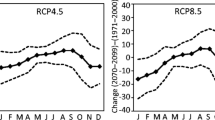Abstract
Historical weather data (1900–2000) of the Southeast U.S.A. was divided into baseline (neutral, 1981–2000), warm (1935–1954) and cold (1958–1977) periods and used in impact simulation experiments to understand climate effects on a summer and a winter crop. Simulated summer crop (maize) yields were lower in the warm than the cold period, but also low during a neutral period. Simulated winter crop (wheat) yields were higher during the neutral period than during the warm and cold periods. A higher average temperature of a given period did not necessarily translate to lower crop yields. Specifically, the summer crop (maize) experienced about 7 % reduction in growing season length per degree increase in mean air temperature, and about 5 % for the winter (wheat) crop. Overall, the simulated maize yield was reduced by 13 % and wheat yield by 6.5 % per unit of increase temperature. In conclusion, simulated yield reduction per unit increase in mean temperature was reduced during the neutral period for the summer while for the winter crop there were fewer differences between the warm and neutral periods. The summer crop was sensitive to changes of mean growing season temperatures while the winter crops was sensitive to changes in CO2.







Similar content being viewed by others
References
Asseng S (2004) Wheat crop systems: a simulation analysis. CSIRO Publishing, Melbourne
Asseng S, Foster I, Turner NC (2011) The impact of temperature variability on wheat yields. Global Chang Biol 17:997–1012. doi:10.1111/j.1365-2486.2010.02262.x
Asseng S et al (2013) Uncertainty in simulating wheat yields under climate change. Nat Clim Chang 3:827–832. doi:10.1038/Nclimate1916
Bassu S et al (2014) How do various maize crop models vary in their responses to climate change factors? Glob Chang Biol 20:2301–2320. doi:10.1111/gcb.12520
Burke MB, Lobell DB, Guarino L (2009) Shifts in African crop climates by 2050, and the implications for crop improvement and genetic resources conservation. Global Environ Chang 19:317–325. doi:10.1016/j.gloenvcha.2009.04.003
Cammarano D et al (2013) Evaluating the fidelity of downscaled climate data on simulated wheat and maize production in the southeastern US. Reg Environ Chang 13:S101–S110. doi:10.1007/s10113-013-0410-1
Carbone GJ, Kiechle W, Locke C, Mearns LO, McDaniel L, Downton MW (2003) Response of soybean and sorghum to varying spatial scales of climate change scenarios in the southeastern United States. Clim Chang 60:73–98. doi:10.1023/A:1026041330889
DeGaetano AT, Allen RJ (2002) Trends in twentieth-century temperature extremes across the United States. J Clim 15:3188–3205. doi:10.1175/1520-0442(2002)015<3188:Titcte>2.0.Co;2
Dettinger MD, Ghil M, Keppenne CL (1995) Interannual and interdecadal variability in United-States surface-air temperatures, 1910–87. Clim Chang 31:35–66. doi:10.1007/Bf01092980
Diaz HF, Quayle RG (1980) The climate of the United-States since 1895 spatial and temporal changes. Mon Weather Rev 108:249–266. doi:10.1175/1520-0493(1980)108<0249:Tcotus>2.0.Co;2
Fowler HJ, Blenkinsop S, Tebaldi C (2007) Linking climate change modelling to impacts studies: recent advances in downscaling techniques for hydrological modelling. Int J Climatol 27:1547–1578. doi:10.1002/Joc.1556
Fraisse CW, Sudduth KA, Kitchen NR (2004) Calibration of the CERES-Maize model for simulating site-specific crop development and yield on claypan soils. Appl Eng Agric 17:10
Godfray HCJ et al (2010) Food security: the challenge of feeding 9 billion people. Science 327:812–818. doi:10.1126/science.1185383
Hansen JW, Jones JW (2000) Scaling-up crop models for climate variability applications. Agric Syst 65:43–72. doi:10.1016/S0308-521x(00)00025-1
Hargreaves GH, Samani ZA (1982) Estimating potential evapotranspiration. J Irrig Drain Eng ASCE 108:6
Hatfield JL et al (2011) Climate impacts on agriculture: implications for crop production. Agron J 103:351–370. doi:10.2134/agronj2010.0303
Hoogenboom G et al (2012) Decision Support System for Agrotechnology Transfer (DSSAT). Version 4.5 [CD-Rom]
Ingram K, Dow K, Carter L, Anderson J (2013) Climate of the Southeast United States: variability, change, impacts, and vulnerability. Island Press, Washington
IPCC (2001) Climate change 2001: the scientific basis. Contribution of working group I. In: Houghton J (ed) Third assessment report of the intergovernmental panel on climate change. Cambridge University Press, Cambridge, p 881
IPCC (2013) Climate change 2013: the physical science basis. Contribution of working group i to the fifth assessment report of the intergovernmental panel on climate change. Cambridge University Press, Cambridge
Jones JW et al (2003) The DSSAT cropping system model. Eur J Agron 18:235–265. doi:10.1016/S1161-0301(02)00107-7
Kunkel KE, Liang XZ, Zhu JH, Lin YR (2006) Can CGCMs simulate the twentieth-century “warming hole” in the central United States? J Clim 19:4137–4153. doi:10.1175/Jcli3848.1
Lobell D, Field C (2007) Global scale climate - crop yield relationships and the impacts of recent warming. Environ Res Lett 2 doi:10.1088/1748-9326/2/1/014002
Lopez-Cedron FX, Boote KJ, Ruiz-Nogueira B, Sau F (2005) Testing CERES-Maize versions to estimate maize production in a cool environment. Eur J Agron 23:89–102. doi:10.1016/j.eja.2005.01.001
Mearns LO, Easterling W, Hays C, Marx D (2001) Comparison of agricultural impacts of climate change calculated from high and low resolution climate change scenarios: Part I. The uncertainty due to spatial scale. Clim Chang 51:131–172. doi:10.1023/A:1012297314857
Moriondo M, Giannakopoulos C, Bindi M (2011) Climate change impact assessment: the role of climate extremes in crop yield simulation. Clim Chang 104:679–701
Ottman MJ, Kimball BA, White JW, Wall GW (2012) Wheat growth response to increased temperature from varied planting dates and supplemental infrared heating. Agron J 104:7–16. doi:10.2134/agronj2011.0212
Porter JR, Gawith M (1999) Temperatures and the growth and development of wheat: a review. Eur J Agron 10:23–36
Williams MD (2010) Characterizing multi-decadal temperature variability in the Southeastern United States. The Florida State University
Acknowledgments
We thank the South East Climate Consortium (SECC) and NOAA’s Regional Integrated Sciences and Assessments (RISA) program for support.
We also thank the anonymous referees for the valuable comments and suggestions that helped improve the manuscript.
Author information
Authors and Affiliations
Corresponding author
Rights and permissions
About this article
Cite this article
Cammarano, D., Zierden, D., Stefanova, L. et al. Using historical climate observations to understand future climate change crop yield impacts in the Southeastern US. Climatic Change 134, 311–326 (2016). https://doi.org/10.1007/s10584-015-1497-9
Received:
Accepted:
Published:
Issue Date:
DOI: https://doi.org/10.1007/s10584-015-1497-9




